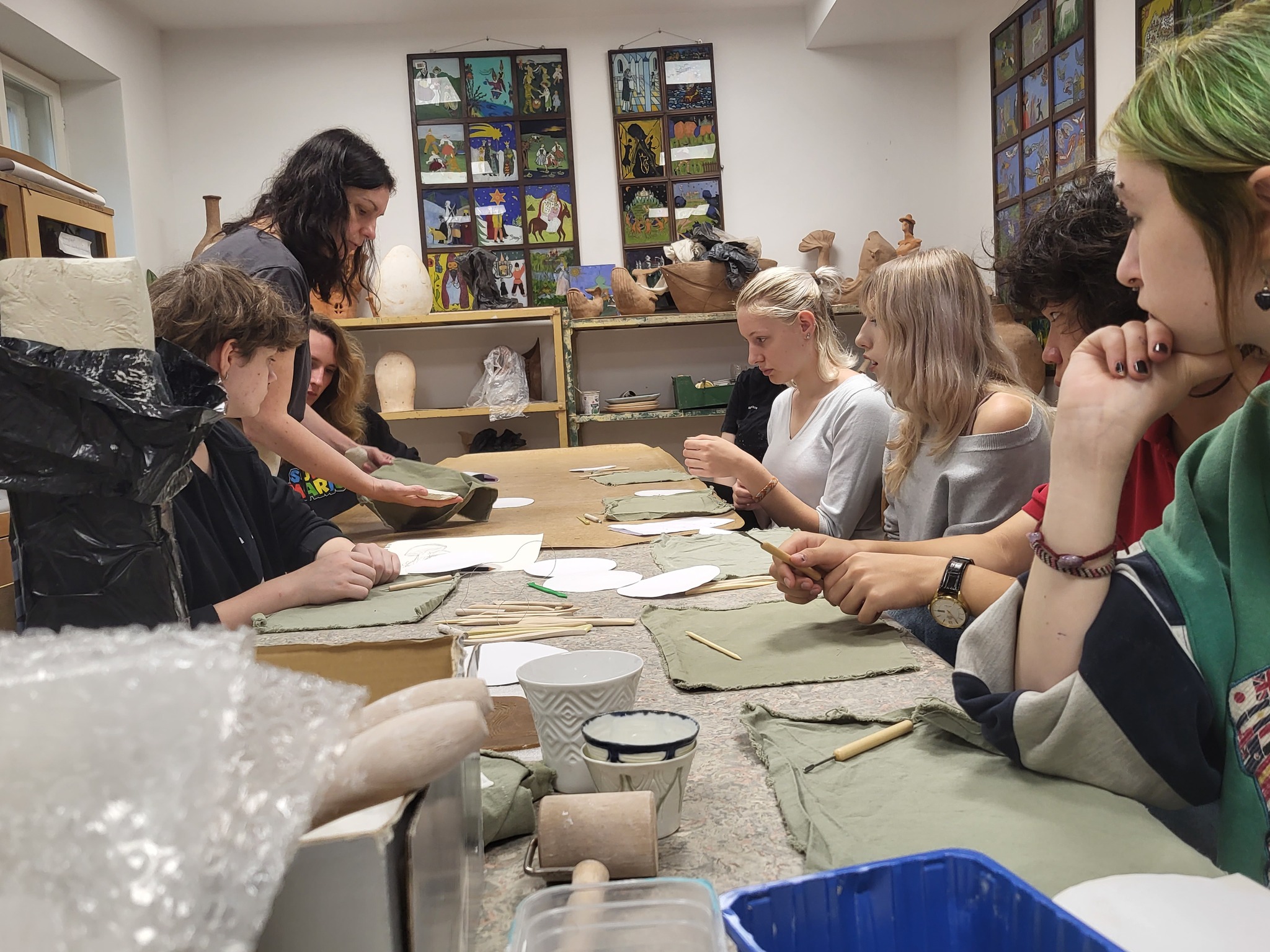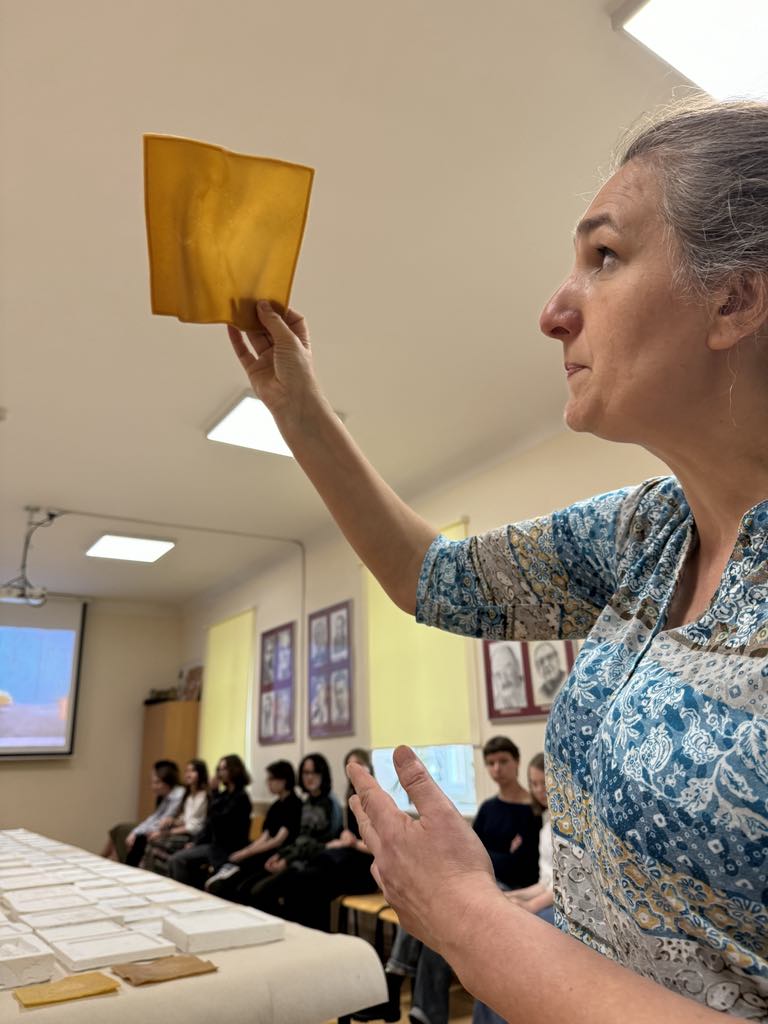“Litophane – what does the heart hold. Mindfulness in relationship with oneself. Painting using the unique porcelain ornamentation technique”
The goal set before the young artists by Aleksandra Biedka, the lead teacher, was to showcase the condition of young creators through the creative process using the delicate medium of porcelain.
The project began in September 2023. The teacher established crucial partnerships for the project’s quality with Polish Porcelain Factory “Ćmielów” and “Chodzież” S.A., based in Ćmielów, Świętokrzyskie Voivodeship, and with the artist Ewa Szlachetka-Depak.
On 19 September 2023, the first lithophane workshops took place in Ćmielów, conducted by Ewa Szlachetka-Depak. The workshops were attended by young people from the third and fourth grades specialising in artistic ceramics, as well as fifth-grade students who had the opportunity to visit the porcelain factory in Ćmielów for the first time. There was also a lecture on the porcelain decoration technique – lithophane – open to interested students and teachers. During the lecture, students were introduced to the works of the artist and designer Roman Szlachetka, whose works intertwine with the porcelain factory in Ćmielów. The artist was discussed by his daughter, sculptor Ewa Szlachetka-Depak, and the artist’s sister Małgorzata Szczygieł, founders of The Roman Szlachetka Lithophane Foundation.

Lithophane workshops with a sculptor, Ewa Szlachetka-Depak
In October 2023, two introductory meetings about practical designing took place. During the design workshop, the young people watched a film about meditation techniques. The students also sought answers to the question posed by the lead teacher: “How are you doing?”

Film about Roman Szlachetka’s life and work in the context of the lithophane technique

First original student works executed in the lithophane technique
In November 2023, the participants worked with plaster moulds from which wax tiles were created. This activity helped test the material, its fragility and transparency. Plaster casts and alphabet stamps were also created. During the design process, the team decided to transform the idea of stamps with ready texts into stamps with individual alphabet letters.
Between 13 and 16 November, a second workshop trip to Ćmielów took place. The students worked on individual projects and a group installation with porcelain tiles.
On the way to the porcelain factory, the students visited the ruins of Krzyżtopór Castle in Ujazd – a significant site in art history, which the students were eager to see in person before graduation.
The students participating in the project recall: “In Ćmielów, on the first day, we intensively prepared workstations and learned the health and safety regulations. The group was supervised not only by teachers but also by Ewa Marcinkiewicz, an educator at the Factory, whose involvement was invaluable. We then toured the facility, learning about all the production stages from design to technology”.
The students also had the opportunity to talk with the chief designer of the Factory, Mariusz Woliński. However, the most important aspect was the process of working with porcelain itself. The students quickly established a good rapport with the employees, who willingly shared their knowledge and demonstrated how to correctly perform the next steps in the complex process.
“Porcelain is a very demanding material; many casts and samples were made, some of which had to be destroyed. This was an important learning stage in working with the material” – says Aleksandra Biedka, the lead teacher.
During their stay at the Factory, Ewa Szlachetka-Depak joined the students, helping them create a mixture of mass with glaze suitable for lithophane, drawing on her father’s working methods.
“We also managed to fire the samples, allowing us to see the finished effects of our lithophane works. It was amazing!” said the students.

Work made using the lithophane technique
During the trip, the students also visited the Historical and Archaeological Museum branch at the Wielopolski Palace in Częstocice.
“There is a collection of porcelain produced in Ćmielów from the factory’s inception to the present. We wanted students to learn about historical Ćmielów Porcelain patterns and see the works of contemporary artists in various artistic fields. Therefore, our next destination was BWA Ostrowiec – a gallery located in an old brewery, where we saw the exhibition Perspective Dwells in the Body by Jakub Ciężki and Lidia Kot”, says Aleksandra Biedka, the lead teacher.
“Just before the holidays, a package with our works from the Ćmielów Factories arrived at the school. It was the most beautiful gift!” the students said.
During the winter break, a group of 10 students and their teachers participated in another workshop trip to the Porcelain Factories. The team brought with them the moulds made at school and made the castings on site at the Factory. Graduating students worked on elements for their projects, while younger students made lithophane casts from all the brought forms. Ewa Marcinkiewicz also suggested casting cups from factory moulds and decorating porcelain with decals and on-glaze paints. The students toured the Factory, moving from the casting line to the decoration department.
In March 2024, the last trip to the Porcelain Factory took place. The workshop focused on detail and decoration. Fourth-grade students glazed cups, rose flower and leaf forms. Graduating students worked on their own pieces. The glazed works went directly into the kiln, with a 7-hour waiting time for firing. During this time, Ewa Marcinkiewicz provided students with porcelain decoration stations, where original decorations based on factory decals were created.
The collective installation at the school took place between 7 and 15 March 2024. Porcelain tiles were transformed into a type of lantern with electric light, providing the proper illumination effect.

Collective Installation presented at the school exhibition in the State High School of Fine Arts in Nowy Wiśnicz

Detail of the installation with an example of lettering

Illuminated detail of the installation

Presentation of works from each stage of project implementation

Aleksandra Biedka, the lead teacher of the project, talks about working with the new material

Illuminated details of the collective installation
Film from the project implementation
The project will be continued. Ideas for another trip emerged at the Factory and were initiated by the students. Aleksandra Biedka and Magdalena Potaczek-Szwed wrote another educational-artistic project entitled “Define the boundary of a dream—create a map on a 1:1 scale leading from the idea to the materialised object - your own vessel”, which was awarded in the 6th edition of the Starak Family Foundation’s “Wena” Grant Programme Competition entitled “Map, scaled one-for-one”. The project will continue to implement the lithophane technology, expanded to include the participants’ own projects.
LEAD TEACHER
Aleksandra Biedka, a teacher of sculpture and architectural structures restoration. For years, she has been conducting extracurricular sculpture classes. Recently, she has collaborated with Polish Porcelain Factory Ćmielów and Chodzież S.A., implementing her own sculptural projects. This collaboration inspired the idea of organising a trip to the Porcelain Factory for a group of interested students from the State High School of Fine Arts Nowy Wiśnicz.
